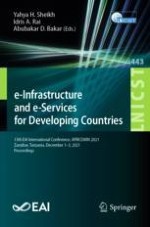2022 | Buch
e-Infrastructure and e-Services for Developing Countries
13th EAI International Conference, AFRICOMM 2021, Zanzibar, Tanzania, December 1-3, 2021, Proceedings
herausgegeben von: Yahya H. Sheikh, Idris A. Rai, Abubakar D. Bakar
Verlag: Springer International Publishing
Buchreihe : Lecture Notes of the Institute for Computer Sciences, Social Informatics and Telecommunications Engineering
